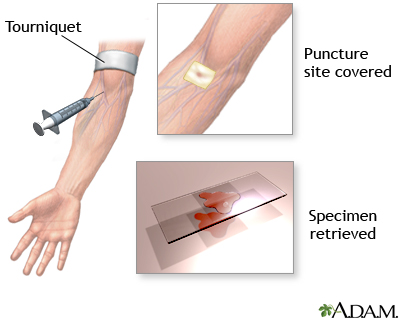Complete blood count
| Indication |
The complete blood count (CBC) is test, used to diagnose and monitor numerous diseases. It can reflect problems with fluid volume (such as dehydration) or loss of blood. It can show abnormalities in the production, life span, and destruction of blood cells. It can reflect acute or chronic infection, allergies, and problems with clotting.
The CBC test identifies and counts the 7 types of cells found in the blood: red blood cell, neutrophil, eosinophil, basophil, lymphocyte, monocyte, and platelet.
|
| Procedure |
A CBC requires a small blood specimen. In most cases, blood is drawn from a vein, usually from the inside of the elbow or the back of the hand. Sometimes, blood is obtained from a fingerprick.
Preparation: The skin should be cleaned with alcohol or iodine before the test. The patient should be seated comfortably or reclining.
How the test will feel:
When the needle is inserted to draw blood, some people feel moderate pain, while others feel only a prick or stinging sensation. After the blood is drawn, there may be some throbbing.
Although the CBC test is very safe, any blood drawing has a very small risk of complication, including:
- Oozing of blood from one puncture site
- Fainting or feeling lightheaded
- Hematoma (blood accumulating under the skin)
- Multiple punctures to locate veins
- Infection (a slight risk any time the skin is broken)
|
| Results, part 1 |
Results: Normal values vary with altitude and gender.
What abnormal results may mean: Low numbers of red blood cells (hematocrit) may indicate anemia, which has many causes, including:
- Blood loss
- Iron deficiencies
- Deficiencies of vitamin B12 or folic acid
- Bone marrow failure (for example, from radiation, toxin, fibrosis, tumor)
- Erythropoietin deficiency (secondary to kidney disease)
- Hemolysis (RBC destruction)
- Leukemia
- Multiple myeloma
- Over hydration
High numbers of red blood cells may indicate:
- Fluids
- Dehydration
- Burns
- Eclampsia
- Erythrocytosis
- Polycythemia vera
Low numbers of white blood cells (leukopenia) may indicate:
- Bone marrow failure (for example, due to granuloma, tumor, or fibrosis)
- Exposure to cytotoxic substance
- Collagen-vascular diseases (such as lupus erythematosus)
- Disease of the liver or spleen
- Radiation exposure
High numbers of white blood cells (leukocytosis) may indicate:
- Infectious diseases
- Inflammatory disease (such as rheumatoid arthritis or allergy)
- Leukemia
- Severe emotional or physical stress
- Tissue damage (for example, burns)
- Certain medicines (such as prednisone and other steroids)
|
| Results, part 2 |
High numbers of red blood cells may indicate:
- Cigarette smoking
- Low oxygen in the blood.
- Congenital heart disease.
- Cor pulmonale.
- Pulmonary fibrosis.
- Polycythemia vera.
- Dehydration (such as from severe diarrhea).
- Emphysema
|

|
Review Date:
12/22/2011
Reviewed By:
Harvey Simon, MD, Editor-in-Chief, Associate Professor of Medicine, Harvard Medical School; Physician, Massachusetts General Hospital. |
The information provided herein should not be used during any medical emergency or for the diagnosis or treatment of any medical condition. A licensed medical professional should be consulted for diagnosis and treatment of any and all medical conditions. Links to other sites are provided for information only -- they do not constitute endorsements of those other sites. © 1997-
A.D.A.M., Inc. Any duplication or distribution of the information contained herein is strictly prohibited.






